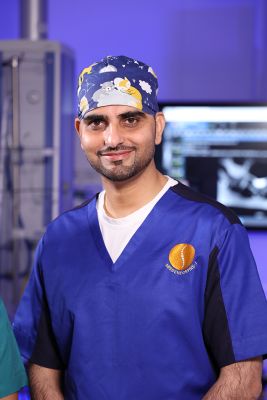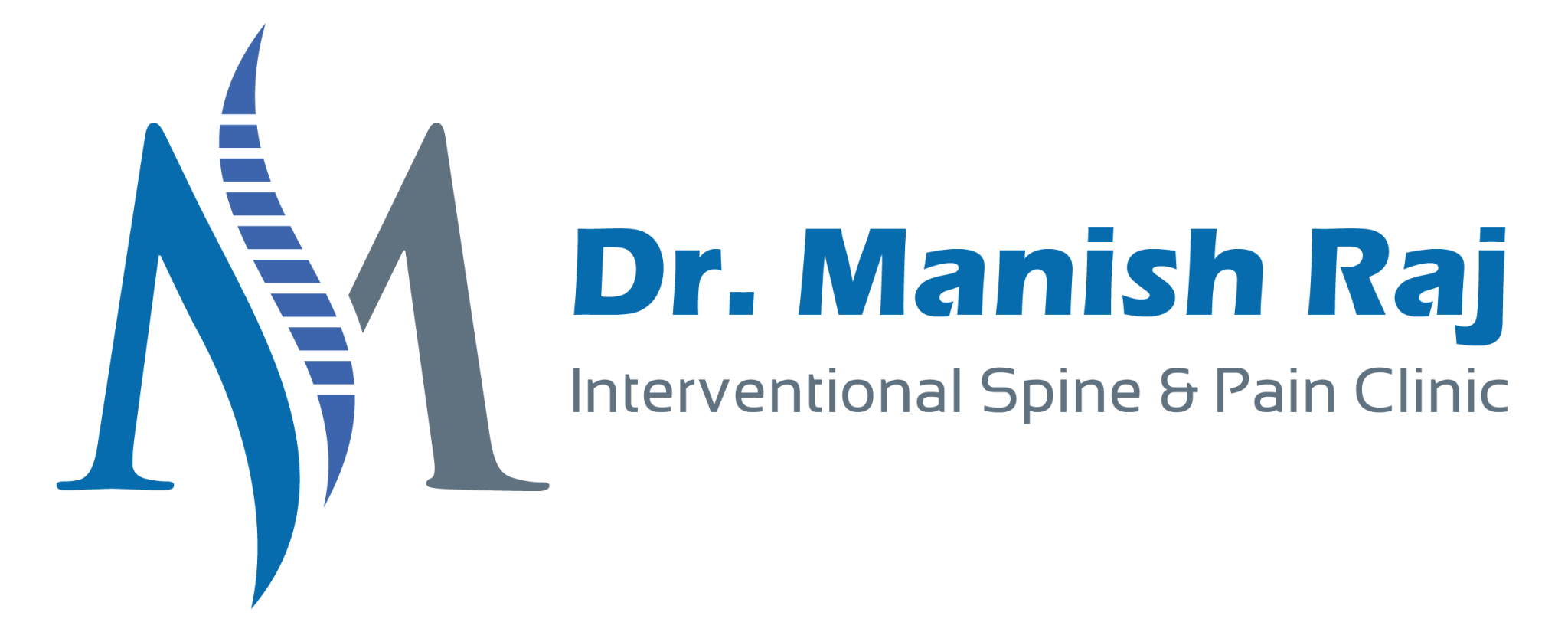Dr. Manish Raj (Specialist Pain Medicine)
Book An Appointment
Fill out the form below or call us at +971 50 480 4987 or email us at [email protected] to book an appointment with us.

Dr. Manish completed his MBBS from Tash Govt. Medical University & Hospital and went on to do his Masters in Anesthesiology & Pain Medicine from Dr. D Y Patil University Medical College, Pune, India, passing out with honors. He further did a Fellowship in Pain Management from AESCULAP Academy, Germany. In 2013, he finished a 2- year fellowship program at the Pain Clinic of India as a Fellow of Interventional Spine and Pain Medicine (FISP) and in 2016.
He received international fellowship in Endoscopic Spine Surgery (IFENDS) after completing advanced endoscopic spine surgery training at the Nanoori Hospital under Pioneer of Endoscopic Spine Surgery Professor Dr Hyeun Sung kim in South Korea.
In 2018, he received Fellowship of the Indian Academy of Pain Medicine (FIAPM) by the Indian chapter of the International Association for the Study of Pain (IASP), the world’s premier organization dedicated to researching and developing guidelines for the diagnosis and treatment of pain.
During his 12 years of practice as an Interventional Spine and Pain Medicine expert, he developed and headed the Department of Interventional Spine & Pain Management at three tertiary care super-specialty hospitals in India. Before joining Mediclinic City Hospital, he was head of the department of interventional pain medicine at Emirates Hospital Group in Dubai, where he introduced advanced endoscopic disc decompression techniques along with many other advanced evidence-based techniques to treat human oldest nemesis “PAIN”.
He has published ground-breaking original scientific research with a technical review of using endoscopic procedures for different types of disc herniation. He has authored and co-authored many research articles in the fields of interventional spine and pain management. He is the only reviewer for the prestigious World Neurosurgery Journal from a pain medicine background and has reviewed 30 scientific publications to date. He is the co-author of the book Atlas of Interventional Pain Management Procedures. Jaypee publishers · Nov 20, 2022, with the contribution endoscopic disc surgery.
He was selected as honorary chairperson of SIG at the Indian Society for the Study of Pain IASP for Endoscopic Spine procedure to provide guidelines for endoscopic spine surgery for society.
He has participated as a Speaker and national Faculty for Advanced Spine Endoscopy at the Indian Society for the Study of Pain national conference (ISSP-2017,2018,2019,20), Faculty for Endoscopic Disc Decompression at the Indian Society for the Pain Clinic (ISPC-2018,2019) & Faculty at Comprehensive Interventional Pain management (CIPM-Mumbai 2016,2017,2018,2019). He was the speaker at the World Trauma Congress 2023 in Dubai on Cervical endoscopic disc decompression and a frequent trainer at All India Institute of Medical Sciences for endoscopic spine surgery.
He has performed more than 5000 spine interventions, with more than 2000 endoscopic spine procedures in the last 12 years. He is a member of the North American Spine Society (NASS), the American Society of Interventional Pain Physicians (ASIPP), and International Association for the Study of Pain (IASP), and the Indian Society of Pain (ISSP) and American Society of Pain & neuroscience (ASPN).
Clinical Expertise:
Spine
- Chronic back pain
- Chronic neck pain
- Cervical degenerative disc disease.
- Lumbar degenerative disc disease.
- Cervical radiculopathy
- Lumbar radiculopathy
- Disc bulge, herniation
- Cervical and lumbar facet pain syndrome
- Failed back surgery syndrome
- Pain after back/spine surgery
- Sciatica
- Spinal stenosis
- Vertebral compression fractures
- Osteoarthritis of the spine
Cancer and Visceral Pain
- Cancer-related pain
- Chronic abdominal pain
- Chronic pelvic pain
Nerve Pain and Musculoskeletal Pain
- Chronic headache and trigeminal neuralgia
- Complex regional pain syndrome (CRPS)
- Shingles pain and post-herpetic neuralgia (PHN)
- Neuropathy including diabetic neuropathy
- Pain after peripheral nerve injuries
- Chronic shoulder pain
- Chronic hip pain and osteoarthritis
- Chronic knee pain and osteoarthritis
- Myofascial muscle pain
Treatment offered:
Interventional Pain Treatments:
- Non-Surgical Treatment of Spine Pain
- Epidural Steroid Injections (ESIs): Often used to treat nerve pain, which radiates from the spine down and can cause sharp pains to shoot from the lower back into the legs, or from the neck into the shoulders and arms.
- Medial Branch Blocks (MBB): Used for the diagnosis and treatment of pain related to arthritis of the small joints of the spine, including neck, mid, and lower back pain. If the patient experiences good pain relief from the procedure, they can be a candidate for radiofrequency ablation.
- Radiofrequency Ablation (RFA): A device is used to deliver an electrical current and heat to the small nerves of the spine and joints. It can provide long-lasting pain relief to patients suffering from chronic neck and back pain as well as patients suffering from knee, hip, and shoulder pain due to arthritis.
- Cooled Radiofrequency Ablation (COLIEF): A device that can help patients suffering from knee, hip, and shoulder pain. This minimally invasive treatment targets nerves that transmit pain signals, and it’s the first and only radiofrequency treatment FDA-cleared for the relief of osteoarthritis knee pain.
- Endoscopic Spine procedure: A minimally invasive spinal technique for the treatment of slip disc, sciatica, and spine joint pain. It is the most advanced and sophisticated technique to address spine problems without the risk of open spine surgery. It has several advantages over conventional spine surgery for back and neck pain. With spine endoscopy, any pain-causing structure of the spine can be addressed with more than a 95% success rate. Spine endoscopy are associated with less muscle injury, preservation of bony structures, and rapid recovery.
- Kyphoplasty and Vertebroplasty: These procedures can be effective in treating people with vertebral compression fractures due to trauma, osteoporosis, or cancer. Kyphoplasty involves cement insertion inside the vertebral body together with the creation of a cavity using a balloon, which allows the cement to be injected before being removed.
- Percutaneous LASER Disc Decompression (PLDD): A minimally invasive laser disc rejuvenation procedure to treat back pain, leg pain, and neck pain caused by herniated discs compressing the nerve in the spine.
- Indirect Spine Fusion: An interspinous-interlaminar fusion device. It is intended to stabilize the thoracic, lumbar, and sacral spine. These devices provide immobilization, stabilization, and fusion of the spinal segments. The core threaded post allows for optimal placement and a wide range of sizes allows for enhanced anatomical fit. These procedures are ideal for lumbar spinal stenosis and can be used with or without graft.
- Sacroiliac Joint Fusion: A fusion procedure is done to reduce the pain from the sacroiliac joint after failure of conservative and injection treatment at the joint. Instruments encourage bone growth over the sacroiliac joint and create one immobile unit, effectively reducing pain and instability caused by sacroiliac joint dysfunction or inflammation (sacroiliitis).
- Differential Target Multiplexed (DTM) Spinal Cord Simulation (SCS): Offers patients the very latest interventional technique, with more than 80% reporting a notable reduction in chronic pain. The implanted DTM device targets neurons, as well as two types of cells involved in the chronic pain pathway, to give exceptional pain relief results. DTM is especially effective in treating patients who are experiencing pain after surgery.
- Dorsal Root Ganglion Stimulation (DRG): A novel device designed for patients suffering from focal neuropathic pain related to complex regional pain syndrome (CRPS). Similar to traditional spinal cord stimulation, DRG delivers electrical signals to the dorsal root ganglion, a bundle of nerves just outside the spinal cord.
- Intrathecal Pump (ITP): A device is implanted that delivers pain medication to the spinal fluid. It helps patients suffering from chronic pain related to cancer or patients with chronic pain where other treatments weren’t successful.
- Platelet-rich plasma Therapy (PRP): A patient’s platelets are injected to improve the function of tissues. The treatment is not widely available in the UAE, but can offer relief for patients following sports injuries, or those affected by osteoarthritis of tendinitis.
